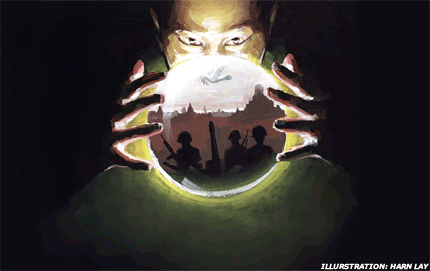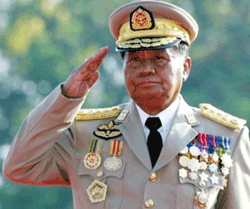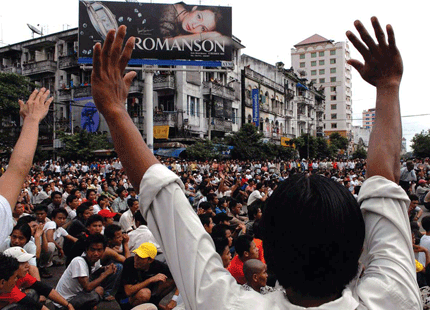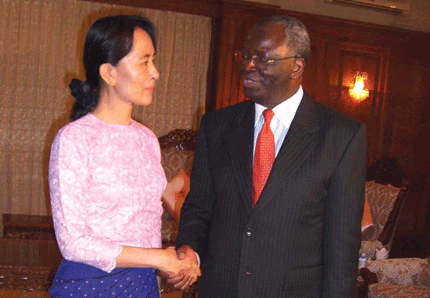
| JANUARY, 2008 - VOLUME 16 NO.1 |
Burma has a road map, but where will it lead?

Than Shwe’s legacy
If Burma’s ailing junta leader Snr-Gen Than Shwe were to die suddenly, his passing could trigger a coup and a fierce power struggle among the top generals and regional commanders. The dictator’s death could also open a window of opportunity for reform-minded military officers to adopt genuine political reform and to enter into political dialogue with the opposition.
 |
| Snr-Gen Than Shwe [Photo: Reuters] |
Than Shwe is also commander in chief of the armed forces, and his death could usher in a more pragmatic leadership possibly led by Gen Thura Shwe Mann or Gen Thein Sein, who may initiate economic reforms. However, hard-liners and Than Shwe loyalists might resist moderate changes, possibly triggering a purge and a coup within the military regime.
It’s believed that reform-minded and moderate officers are to be found within the armed forces. Since the bloody crackdown on demonstrating monks and other protesters in September, an increasing number of these officers, unhappy with the current military leadership, are reported to be in favor of change and international intervention.
They also expect the UN and powerful neighbors to employ positive and aggressive diplomacy to bring about change in Burma. It’s believed that they want to see a meaningful compromise with the opposition and Aung San Suu Kyi’s National League for Democracy, the landslide winner of the 1990 election.
These moderate forces may believe that reconciliation with Suu Kyi can bring a lasting political settlement as well as economic prosperity, foreign investment and development aid from the international community. If they receive encouragement and support from within and outside the armed forces, they may remove Than Shwe and his regime.
Another uprising?
Many observers are predicting another uprising in 2008, again led by monks and with the participation of students.
Members of Burma’s apolitical younger generation, who had no experience of the 1988 student-led uprising, were hugely inspired by the September demonstrations. Throughout the country, they formed cells and underground groups networking each other and keeping contact with the outside world and exile groups through the use of cell phones, digital cameras, e-mail and Internet blog sites. They were far better equipped than the activists and students of 1988.
 |
| Many observers predict more domonstrations in 2008 [Photo: Thierry Falise] |
This new generation could be a political opposition to be reckoned with, but unfortunately they are likely to remain an immature and decentralized force in dealing with the regime.
The country’s dire economic condition, the political stalemate, growing dissent and the regime’s intransigence fill the powder barrel for a major uprising in the near future. Influential abbots and religious and social leaders will be aggressively involved in any uprising and in shaping the future of Burma.
The worst-case scenario would be the death of Aung San Suu Kyi, who is now 62. Junta leaders may be waiting for her to pass away, leaving the National League for Democracy party without her leadership. Her death, however, could trigger a new uprising, resulting in another bloody crackdown and political turmoil in the country.
The ‘road map’
If the UN, Asean, China and the international community cannot influence positive change and a reconciliation process in Burma, the country’s military leaders will continue to implement their seven-point “road map.”
The completion of the “road map” will guarantee that the regime holds power indefinitely and will legitimize the role of the military dynasty in Burma.
The junta’s Committee for Drafting of a New Constitution has started the process of drafting the new constitution, the third stage of the seven-step “Road Map to a New Democratic State.” Recently, 54 people were appointed to the committee and no completion date was announced.
When the “road map” was announced in August 2003, the seven steps were listed as: (1) reconvening the National Convention; (2) implementation of a process to allow the emergence of a ‘genuine and disciplined democratic system’; (3) drafting a new constitution; (4) the adoption of a constitution through a national referendum; (5) free and fair elections; (6) convening elected bodies; (7) the creation of government organs instituted by the legislative body.
The first step of the road map was completed in 2007.
Burma watchers say the timeframe provides for a referendum and elections in 2008, with a new, elected government in place by 2009.
However, the September pro-democracy uprising has thrown the entire process in doubt. The brutal crackdown on the demonstrations has placed a roadblock on the map, and, as a result, the regime leaders may not dare to hold an election in the near future for fear of inevitable defeat.
If the military government continues to push forward with its “road map,” it will only complicate the political deadlock, with mainstream opposition groups from inside and outside Burma probably becoming more marginalized.
A peaceful settlement?
The best solution to Burma’s problems, of course, remains a peaceful political settlement between opposition groups and the military leaders. And the “best of the best” would be an agreement to form an interim government including opposition figures.
 |
| Junta-appointed delegates to the National Convention [Photo: Reuters] |
Despite the regime’s appointment in October of a minister to liaise with Suu Kyi, it remains doubtful that the military leaders are interested in a serious dialogue with her and other opposition representatives, groups and ethnic leaders.
Nevertheless, regime leaders could still enter genuine and serious dialogue with the opposition parties and make political concessions, if they really felt they were under pressure from neighboring countries and from domestic and international agencies.
Some genuine gesture is needed ahead of a political settlement, however—the release, for example, of all political prisoners, including Suu Kyi, Tin Oo, the Shan leader Hkun Htun Oo and the 88 Students Generation pioneer Min Ko Naing; the declaration of a nationwide ceasefire; and peace agreements with non-ceasefire groups among the Karen, Karenni and Shan.
The regime and opposition groups need to create an atmosphere of peace and to call for unity and national reconciliation and preparations for a transition period.
After the start of serious political negotiations between the regime and the political opposition, the UN and the international community would continue to assist the reconciliation process and offer technical assistance and aid packages to Burma.
In the event of meaningful moves toward compromise by the junta, Asean, China, the US and the EU should work together to provide assistance to Burma. They could send fact-finding missions and high-level delegations to Burma for talks with both the regime and opposition groups, encouraging further political settlements and signaling an end to visa bans and a partial lifting of economic sanctions on junta leaders and their cronies.
It is still not possible for Suu Kyi and opposition groups to call for an end to Western sanctions—that would be political suicide. However, if substantive progress were achieved on the political front, opposition circles inside and outside Burma could advise the West to adopt a positive approach towards the regime.
The International Monetary Fund and the World Bank could be invited to study and assist infrastructure and development projects and soft loans to help Burma solve its economic ills.
The National Convention could still be a venue to achieve national reconciliation. However, the original “road map” should be amended to become an inclusive plan for all parties, allowing ethnic and NLD leaders to participate in the current constitution-drafting process.
Catastrophe and humanitarian intervention
If the current political stagnation continues, Burma could, within the next 20 years, become a totally failed state and the cause of serious instability in the region and beyond.
 |
| Aung San Suu Kyi and UN envoy Ibrahim Gambari [Photo: UNIC Yangon] |
Refugees, internally displaced people, forced migration, tensions within ethnic groups, drugs, health issues, poverty and economic malaise—these endemic problems could mount to the point where the regional and international community has to intervene.
The UN, Asean, China and Western governments would no longer be able to pay lip service to the regime. They might be compelled to enforce a political settlement, replacing the military regime with a civilian-dominated administration that includes moderate military leaders.